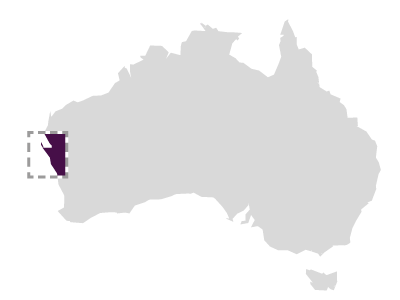Hugh Norman (1910/10/28)
Opposite Green Island about 17 miles from Namban right between two small islands and the shore about 80 yards from the beach

Breadth: 12.6 ft (3.8 m) (Dickson, 1996), 11.6 ft (3.55 m) (McKenna, 1959)
Hugh Norman was built by Alfred Edmund Brown at Fremantle. The owners were Robison & Norman Ltd, merchants of Broome. It was on its delivery voyage under the command of W. Dundee when wrecked. The date of 1928 as the date of wrecking in McKenna appears in error, and 1910 is correct although the exact day is in dispute. McKenna (1959) states that the registry was closed on 8 February 1911 and cancelled on 1 May 1911.
THE LOSS
McKenna (1959) states that the Hugh Norman was ‘totally wrecked in vicinity of Cervantes Is’. However McKenna (1967) shows the place of wrecking as ‘near the mouth of the Moore River’. Dickson (1996) states that it was wrecked in the vicinity of Cervantes Island. WAM File MA-118/80 shows that it was wrecked in the vicinity of Cervantes Island, owing to the skipper being drunk. Goldsmith gives the full story and states that the date it struck the reef was 24 October 1910.
The Hugh Norman was due to depart Fremantle on 20 October when the authorities detained it because the skipper was hopelessly drunk and obviously incapable of properly sailing the vessel. The schooner sailed the following morning, after the owner’s agent had confiscated what he thought was the only remaining bottle of liquor aboard. Anderson, the only crew, was given the course to steer and the master went below. Later that day when the wind increased the crewman went below to ask Dundee what needed to be done. He found the master drunk again with two whisky and two methylated spirits bottles rolling around empty on the cabin sole. The wind continued to increase but the task of altering or reefing sail required two men, so Anderson could do nothing except steer, until at dusk on 21 October the foremast snapped.
Captain Dundee came on deck about 8.00 p.m. but made no effort to clear the wreckage of the mast trailing alongside, and went below again. Anderson continued steering until just after sunset on 22 October when the skipper again came on deck and finally took over the helm. Anderson cut away the foremast and its sail and rigging, and rigged a jury staysail on the mainmast. He then went below to sleep, but was woken the next afternoon by the flapping of the sails. He went on deck to find the skipper asleep at the tiller. Anderson took over the helm, and about midnight sighted land. He notified the captain who appeared disinterested. About 2.00 a.m. on 24 October the Hugh Norman struck a reef about five miles from shore.
An attempt was made to lower the ship’s boat but this became half swamped, the painter snapped, and it drifted away from the schooner. Dundee ordered Anderson to swim and bring the dinghy back, but Anderson refused, pointing to sharks swimming near the vessel. A fight ensured and Anderson suffered a severe bite to one of his fingers. The skipper then went below, where he stayed for two days as the vessel slowly drifted towards the shore, bumping over reefs as it went and with the leaks worsening. On 26 October the skipper came on deck and assisted with bailing out the water in the schooner. He then returned to his cabin. At 9.00 p.m. the following night Captain Dundee jumped overboard and attempted to swim for the shore.
In the afternoon of 28 October Anderson abandoned the Hugh Norman, which was by this time about one mile from shore. He made this decision because the wind had turned to the east, and he was afraid that it would blow the vessel back out to sea. After reaching shore he made an unsuccessful search for Dundee, then began to walk along a cart track that he came across. He followed this for five days with no food and little water before arriving at the homestead of Leslie Brown near Moora.
INQUIRY
A Marine Inquiry found: ‘The loss of the vessel was occasioned by the misconduct of the master, to wit, drunkenness and neglect of duty and navigation through excessive indulgence in intoxicating liquor. That as the master…lost his life in a vain attempt to swim ashore, no further action be taken’ (Quoted in Goldsmith, 1946: 194).
Alfred Edmund Brown, builder of the Hugh Norman, has been described as Western Australia’s most prolific boat and shipbuilder. At the peak of his production Alfred Brown was turning out a vessel every fortnight. Many of his boats were built for the pearling industry, but he also built yachts, barges and ferries. Some of his best known creations are the ferry Perth, the pearling lugger Aurora which at one stage held the record of seven days and twenty three hours between Fremantle and Broome, and the steam launch Ti-Tu presently held at the Western Australian Maritime Museum (Dickson, 1998).
Ship Built
Owner Robison & Norman Ltd. of Broome
Master W. Dundee
Builder Builder Alfred Edmund Brown
Country Built WA
Port Built Fremantle
Port Registered Fremantle
When Built 1910
Ship Lost
Grouped Region Mid-West
Sinking By drunkenness and neglect of duty and navigation through excessive indulgence in intoxicating liquor
Crew 2
Deaths 1
When Lost 1910/10/28
Where Lost Opposite Green Island about 17 miles from Namban right between two small islands and the shore about 80 yards from the beach
Port From Fremantle
Port To Broome
Ship Details
Engine N
Length 11.50
Beam 3.80
TONA 10.42
TONB 12.42
Draft 1.50
Museum Reference
Official Number 125030
Unique Number 1327
Registration Number 22/1910
Sunk Code Wrecked and sunk
Chart Number 1033
Protected Protected Federal
Found N
Inspected N
Confidential NO